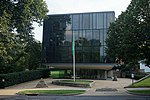Charles C. Glover Memorial Bridge
1939 establishments in Washington, D.C.Arch bridges in the United StatesBridges completed in 1939Bridges over Rock Creek (Potomac River tributary)Concrete bridges in the United States ... and 5 more
Embassy RowHistoric American Engineering Record in Washington, D.C.Road bridges in Washington, D.C.Southern United States bridge (structure) stubsWashington, D.C., building and structure stubs

The Charles C. Glover Memorial Bridge or Massachusetts Avenue Bridge in Northwest Washington, D.C. conveys Massachusetts Avenue over Rock Creek and Rock Creek Park. The concrete arch bridge was constructed in 1939–41 and has a length of 386.2 feet (117.7 m).
Excerpt from the Wikipedia article Charles C. Glover Memorial Bridge (License: CC BY-SA 3.0, Authors, Images).Charles C. Glover Memorial Bridge
Waterside Drive Northwest, Washington
Geographical coordinates (GPS) Address External links Nearby Places Show on map
Geographical coordinates (GPS)
| Latitude | Longitude |
|---|---|
| N 38.917777777778 ° | E -77.058333333333 ° |
Address
Charles C. Glover Memorial Bridge (Massachusetts Avenue Bridge)
Waterside Drive Northwest
20008 Washington
District of Columbia, United States
Open on Google Maps










